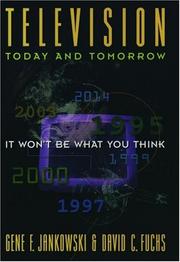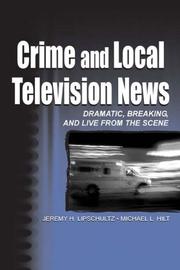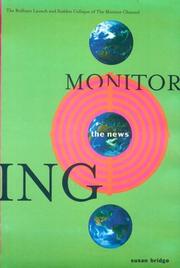| Listing 1 - 10 of 69 | << page >> |
Sort by
|

ISBN: 1315290928 1315290936 131529091X 9781315290928 9781315290911 0765609223 9781315290935 9781315290904 9780765609229 9780765609236 0765609231 Year: 2015 Publisher: Loneon : Routledge,
Abstract | Keywords | Export | Availability | Bookmark
 Loading...
Loading...Choose an application
- Reference Manager
- EndNote
- RefWorks (Direct export to RefWorks)
Book
Abstract | Keywords | Export | Availability | Bookmark
 Loading...
Loading...Choose an application
- Reference Manager
- EndNote
- RefWorks (Direct export to RefWorks)
First published in 1980, More Bad News is the Second Volume in the research findings of the Glasgow University Media Group. It develops the analytic findings and methods of the first volume Bad News through a series of Case Studies of Television News Coverage, and argues that much of what passes as balanced and factual news reporting is produced from a highly partial viewpoint. Focusing on the British economy in crisis, and its thematic linkage with the Social Contract during the first four months of 1975, the book deals with three main levels of activity: the story, the language and the visuals. As the book unpacks each level of routine news coverage a picture emerges which has the surface appearance of neutrality and balance but is in fact highly partial and restricted.
Journalism --- Television broadcasting of news --- Objectivity.

ISBN: 9780521871150 9780521691543 0521871158 0521691540 9780511841064 0511286082 9780511286087 0511284527 9780511284526 0511285345 9780511285349 9780511286803 0511286805 051184106X 9786610909971 6610909970 1107180236 9781107180239 1280909978 9781280909979 0511323115 9780511323119 Year: 2007 Publisher: New York Cambridge University Press
Abstract | Keywords | Export | Availability | Bookmark
 Loading...
Loading...Choose an application
- Reference Manager
- EndNote
- RefWorks (Direct export to RefWorks)
Local television newscasts around the country look alike and are filled with crime, accidents, and disasters. Interviews with more than 2,000 TV journalists around the country demonstrate that news looks this way because of the ingrained belief that 'eye-ball grabbers' are the only way to build an audience. This book contradicts the conventional wisdom using empirical evidence drawn from a five-year content analysis of local news in more than 154 stations in 50 markets around the country. The book shows that 'how' a story is reported is more important for building ratings than what the story is about. Local TV does not have to 'bleed to lead'. Instead local journalists can succeed by putting in the effort to get good stories, finding and balancing sources, seeking out experts, and making stories relevant to the local audience.
#KVHA:Journalistiek --- #KVHA:Berichtgeving --- Television broadcasting of news

ISBN: 0198023871 1282384023 9786612384028 1423740440 0195344413 1602566453 9780198023876 9780195344417 9780195074871 9780195111293 0195074874 9780195074871 019511129X 9780195111293 9781423740445 9781282384026 6612384026 9781602566453 0197726364 Year: 2023 Publisher: New York ; Oxford University Press,
Abstract | Keywords | Export | Availability | Bookmark
 Loading...
Loading...Choose an application
- Reference Manager
- EndNote
- RefWorks (Direct export to RefWorks)
This study explores the state of television today and its future role in society. It explores the gathering and reporting of television news, government regulations, and the new technologies that will take television into the 21st century.
Television programs --- Television broadcasting --- Television broadcasting of news

ISBN: 1282326511 9786612326516 1410606589 9781410606587 9780805836219 0805836217 0805836209 0805836217 9780805836202 9781282326514 6612326514 9781135657062 9781135657109 9781135657116 Year: 2002 Publisher: Mahwah, N.J. L. Earlbaum Associates
Abstract | Keywords | Export | Availability | Bookmark
 Loading...
Loading...Choose an application
- Reference Manager
- EndNote
- RefWorks (Direct export to RefWorks)
This volume offers an analysis of crime coverage on local television, exploring the nature of local television news and the ongoing appeal of crime stories. Drawing on the perspectives of media studies, psychology, sociology, and criminology, authors Jeremy H. Lipschultz and Michael L. Hilt focus on live local television coverage of crime and examine its irresistibility to viewers and its impact on society's perceptions of itself. They place local television news in its theoretical and historical contexts, and consider it through the lens of legal, ethical, racial, aging, and technological con
Book
ISBN: 1849666474 1849666482 9781849666480 Year: 2011 Publisher: New York : Bloomsbury Academic,
Abstract | Keywords | Export | Availability | Bookmark
 Loading...
Loading...Choose an application
- Reference Manager
- EndNote
- RefWorks (Direct export to RefWorks)
"This book traces the history of television journalism in Britain from its austere roots in the BBC's post-war monopoly to the present-day plethora of 24 hour channels and celebrity presenters. It asks why a medium whose thirst for pictures, personalities and drama makes it, some believe, intrinsically unsuitable for serious journalism should remain in the internet age the most influential purveyor of news. Barnett compares the two very different trajectories of television journalism in Britain and the US, arguing that from the outset a rigorous statutory and regulatory framework rooted in a belief about the democratic value of the medium created and sustained a culture of serious, responsible, accurate and interrogative journalism in British television. The book's overarching thesis is that, despite a very different set of historical, regulatory and institutional practices, there is a very real danger that Britain is now heading down the same road as America."--Bloomsbury Publishing.

ISBN: 1315702304 1317464443 9781317464440 9781315702308 9781317464457 1317464451 9781317464433 1317464435 0765603152 9780765603159 9780765603166 0765603160 9780765603159 Year: 2015 Publisher: London
Abstract | Keywords | Export | Availability | Bookmark
 Loading...
Loading...Choose an application
- Reference Manager
- EndNote
- RefWorks (Direct export to RefWorks)
Between 1988 and 1992 a technologically sophisticated leadership at the "Christian Science Monitor" led a costly campaign to diversify beyond the failing newspaper to other media, including a cable TV channel. This text tells the story of the Monitor and its loss to American journalism.
Book
ISBN: 1135229759 1135229767 1282444174 9786612444173 0203092635 9780203092637 1135176140 9781135176143 1282443720 9781282443723 9786612443725 6612443723 0203092643 9780203092644 Year: 2010 Publisher: London Routledge
Abstract | Keywords | Export | Availability | Bookmark
 Loading...
Loading...Choose an application
- Reference Manager
- EndNote
- RefWorks (Direct export to RefWorks)
It is a commonly held belief that television news in Britain, on whatever channel, is more objective, more trustworthy, more neutral than press reporting. The illusion is exploded in this controversial study by the Glasgow University Media Group, originally published in 1976.The authors undertook an exhaustive monitoring of all television broadcasts over 6 months, from January to June 1975, with particular focus upon industrial news broadcasts, the TUC, strikes and industrial action, business and economic affairs.Their analysis showed how television news favours certain indivi
Television broadcasting of news --- Broadcast journalism --- Journalism --- Objectivity.
Book
Year: 2015 Publisher: London : Bloomsbury,
Abstract | Keywords | Export | Availability | Bookmark
 Loading...
Loading...Choose an application
- Reference Manager
- EndNote
- RefWorks (Direct export to RefWorks)
"The objective of this book is to convince readers that the way we approach current affairs issues can be strengthened through recourse to social theory. Through a series of graphic case studies it shows how social theory can provide systematic and penetrating 'ways of seeing' current affairs issues that enable us to critically assess the quality of current affairs coverage. Each chapter focuses on a major issue in current affairs, such as the support of democratic movements against dictatorships, the question of centralised control and regulation, and the justification for non-intervention in the face of atrocitites. In each case Stones first looks at the nature of current affairs texts, whether in the form of print, radio, television, documentary or web journalism or their representation in novels, drama, art or film. He then goes on to look at the ways in which social theory can inform the way audiences interpret what they view and read, including how they think about the relationships between what they are offered by the different genres. The book serves not only to make social theory relevant for students but also teaches all of us how our understanding of current affairs can be enhanced through an engagement with sociological principles."--
Television broadcasting of news --- Mass media --- Objectivity. --- Social aspects.
Book
ISBN: 0190655747 0190655739 9780190655747 9780190655754 0190655755 9780190655730 9780190655723 Year: 2017 Publisher: New York, NY
Abstract | Keywords | Export | Availability | Bookmark
 Loading...
Loading...Choose an application
- Reference Manager
- EndNote
- RefWorks (Direct export to RefWorks)
| Listing 1 - 10 of 69 | << page >> |
Sort by
|

 Search
Search Feedback
Feedback About UniCat
About UniCat  Help
Help News
News